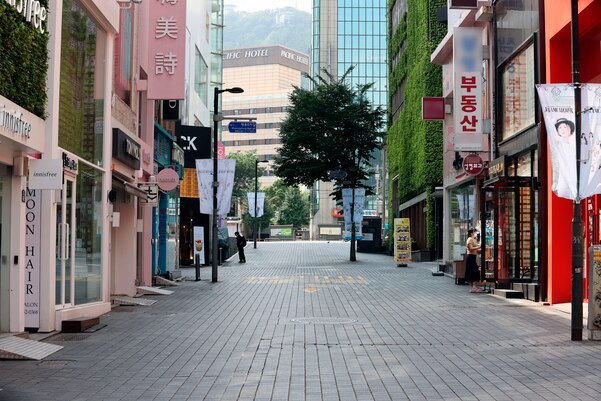 |
A street in Myeongdong, one of the busiest shopping districts in Seoul, stands nearly empty. (Yonhap) |
Responding to the economic fallout from the COVID-19 pandemic, South Korea’s middle-income households turned out to have reduced private spending more sharply than those in the upper and bottom income brackets, state-run think tank Korea Development Institute said Monday.
The nation’s middle class, which generally refers to households belonged to the third highest income quintile that earn 40 percent to 60 percent of the median income, saw its consumption expenditures shrink 6.8 percent on-year in 2020, far above the average reduction rate of 2.8 percent, the KDI said in its report on the economic impact of the COVID-19 pandemic on household spending.
An income quintile divides the population into five equal income groups. The first quintile refers to those with the lowest income, and the fifth, the highest.
The fourth quintile with the upper 20 to 40 percent income range, which is also generally considered part of the middle class, saw a 4.2 percent decrease in household spending in the same year. The figure is higher than the second quintile, or the bottom 20 to 40 percent, which posted 3.3 percent.
On the contrary, households in the upper and lower class, however, were less likely to tighten their belts, with the top 20 percent income bracket’s private consumption decreasing merely 0.8 percent, while the bottom 20 percent in income distribution saw a 2.8 percent increase in their spending.
Families belonging to the lower income brackets could spend more as their disposable income gained at a faster pace than those of the middle-income households, largely due to the government’s financial stimulus packages, including selective cash handouts, which targeted vulnerable social groups, the report explained.
While the disposable income of the first and second quintile rose 7.5 percent and 4.6 percent, respectively, that of the third and fourth quintile advanced less than 2 percent.
Disposable income is what is left of their salaries after they pay taxes and spending on goods and services, including food and shelter.
“People in the middle-income bracket were most affected by the economic shock of the COVID-19 crisis throughout last year. It seems that they have responded to the protracted pandemic by reducing consumer spending, while increasing savings,” said Nam Chang-woo, a researcher at the KDI.
By Choi Jae-hee (
cjh@heraldcorp.com)








